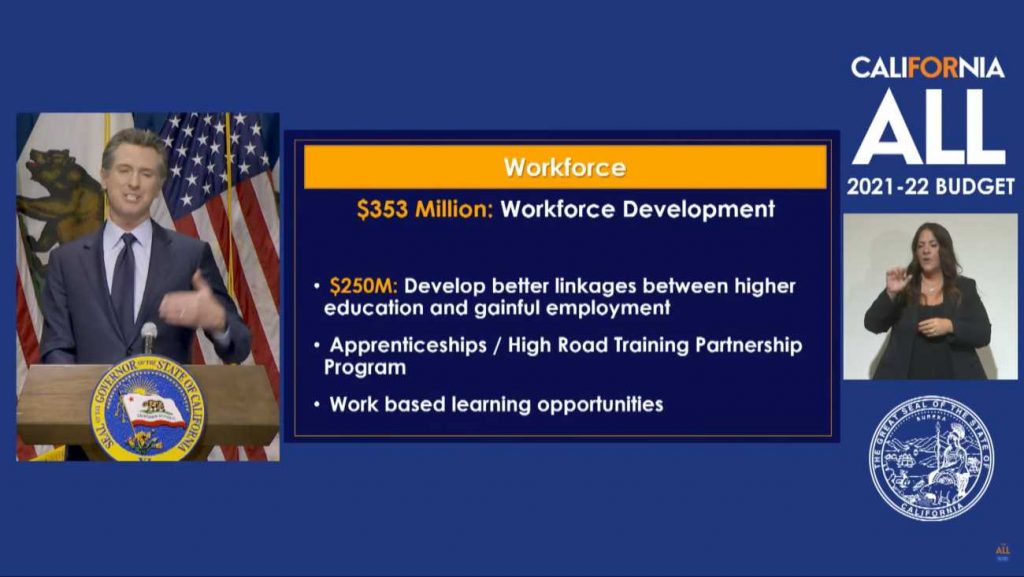Governor’s January Budget Proposal Reinvests in California’s Higher Education System

California enters 2021 with a more cautiously optimistic budget than what was enacted in June 2020, as shown in the Governor’s 2021-22 Budget Proposal. The budget proposes no cuts to the University of California (UC), the California State University (CSU), and the California Community Colleges (CCC) and instead offers funding increases to address equity gaps, promote completion rates, and support students’ upward economic mobility. These investments allow for our higher education institutions to be more efficient, resilient, and just, which will help our state to grow even stronger than before. As such, we are especially pleased that the Governor’s proposed budget directly addresses policy priorities California Competes has identified as being critical to the state’s recovery and resiliency:
- Enhancing higher education and workforce alignment;
- Making online education effective and accessible;
- Supporting adult learners to and through college; and
- Implementing the statewide longitudinal data system.
This year’s proposal emphasizes higher education as a key pathway for Californians to develop the skills needed to drive the state’s economy. It includes a $250 million one-time investment to support workforce development and strengthen the connection between higher education and employment. It also proposes $786 million for the UC and the CSU with the expectation that they reduce equity gaps, align student learning objectives with workforce needs, and grow online educational opportunities. Other specific higher education investments include:
- $70 million to improve the linkage between higher education and workforce related to work-based learning and career technical education, including:
- $15 million in ongoing investments to augment the California Community Colleges California Apprenticeship Initiative;
- $20 million in one-time investments to expand work-based learning models and programs at community colleges;
- $20 million in one-time investments to four science and innovation institutes established on UC campuses to support internship stipends for students over a five-year period and for research teams to link with industry partners to better align educational programs with workforce needs; and
- $15 million in one-time funding to support the continued development of the Cradle-to-Career Data System, plus an additional $3.8 million ongoing for the California College Guidance Initiative;
- $78.6 million to promote accessible and quality online education, including:
- $60 million in ongoing investments to support students with electronic devices and high-speed internet connectivity and to increase student mental health resources—$30 million for community college students, $15 million for CSU students, and $15 million for UC students;
- $10.6 million in ongoing investments to support the continuity of education and quality distance learning, including access to online tutoring, online counseling, and online student support services including mental health services at community colleges; and
- Increase of $8 million in ongoing investments in community colleges and $246,000 ongoing investments in the CSU for cost increases associated with continued broadband access provided by the Corporation for Education Network Initiatives in California (CENIC).
- $205 million to support student financial assistance and improve college affordability:
- $150 million in one-time investments for emergency financial assistance for full-time, low-income community college students and other students who were previously working full-time, or equivalent to full-time, who can demonstrate an emergency financial need;
- Increase of $35 million in ongoing investments to add 9,000 Cal Grant Competitive awards, which serve older, low-income adult students; and
- Increase of approximately $20 million in ongoing investments to increase the access awards for former or current foster youth who receive Cal Grant A, B, or C awards.
These investments were likely finalized before the federal relief package was passed in late December. It’s expected that California’s higher education systems would receive $2.9 billion in additional support, which may shift the state’s spending plan.
The state’s economic recovery will benefit from a concerted effort to restructure higher education to better serve California, including increasing higher education’s alignment to workforce needs, addressing structural inequities, and ensuring we learn from 2020 to emerge stronger than ever. We see those intentions in Governor Newsom’s proposed budget.
Dr. Su Jin Gatlin Jez
“For current college students and those Californians who wish to pursue postsecondary education, these investments cannot come soon enough,” said California Competes Executive Director Dr. Su Jin Gatlin Jez. “The state’s economic recovery will benefit from a concerted effort to restructure higher education to better serve California, including increasing higher education’s alignment to workforce needs, addressing structural inequities, and ensuring we learn from 2020 to emerge stronger than ever. We see those intentions in Governor Newsom’s proposed budget.”
Investing in higher education institutions and students is critical to restoring the state’s economy and elevating the economic and social mobility that has evaded too many Californians for far too long—well before the pandemic. We see promise in this initial budget proposal and look forward to continuing our work with the administration and the State Legislature to ensure that our higher education institutions continue to be the backbone of a sustainable economy fueled by a skilled, diverse workforce.